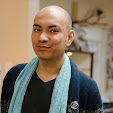When we would visit Pennsylvania for trade shows, I noticed the brightly colored decorations on the barns. I love folk art and was intrigued by the iconography. When we moved here, I became even more curious and remember asking an older local what they meant. I was told, "Oh, that's so the barn don't burn." Apparently they are Pennsylvania Dutch Hex Symbols and different symbols represent different petitions. They are basically painted prayers.
As an artist who infuses my work with mindful intention, this is really interesting to me.
Now that I'm aware of them, I see them all over. They're tucked in the eaves of churches and barns and there was even one hanging in our kitchen when we bought the house. It's fascinating to me. What I find particularly interesting is that it's not exclusively "pagan" or "Christian". It seems like a lovely swirl of beliefs and traditions that have been passed down in the region. I like when things cross boundaries and blur the lines.
What's perhaps not discussed as much are the beliefs attached to the hex symbols. To learn more about them, the origins, the uses, and how they are used, I wanted to do a little research about Pow-Wow and Braucherei. Here's a view books on my reading list: "The Long Lost Friend" by John George Hohman, "Hex and Spellwork" by Karl Herr, "The Powow Grimoire" by Robert Phoenix, "Folk Medicine Plants Used in the Pennsylvania Dutch Country" by Paul R. Wieand, "HexCraft: Dutch Country Magick" by Silver RavenWolf, and "The Red Church or The Art of Pennsylvania German Braucherei" by C.R. Bilardi. I also picked up a little book called, "Hexology: The History & the Meaning of the Hex Symbols" by Jacob Zook and Jane Zook.
I'm curious to see how this will impact my own work and if these symbols will start appearing in my own work.
Subscribe to:
Post Comments (Atom)
















No comments:
Post a Comment